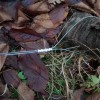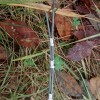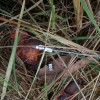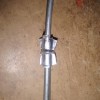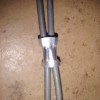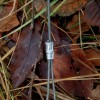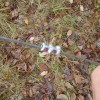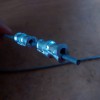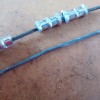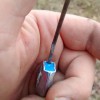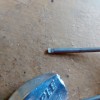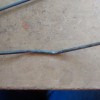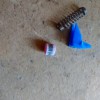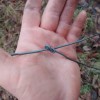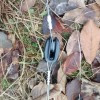Crimp Sleeve Testing
The first fence I built in 2015 was constructed using the traditional wire knots or twisting of the wire around where corner strain insulators needed to be connected. This fence has held up well for the past year, although the plastic corner insulators show some signs of wear from the wire, which suggests that they aren't a long term good choice and may eventually fail-- time will tell. However, this fence hasn't suffered any trees falling into it nor is it holding in cattle, so I revisited the issue of connecting wires this year.
Many sources state that wire knots on high tensile wire have only 60 - 70% of the strength of the wire, likewise any direct wire-wire splicing method. Recommended practice is to use instead crimp sleeves, however previously I was unable to locate those on the Slovak market-- they were not carried by any of the companies selling electric fence components, nor by the company selling viticulture supplies from whom I bought the high tensile wire. This year the viticulture company started carrying them, however at 0,75€ a piece they are a bit pricey. Fortunately, now knowing how they are called, I was able to find a Czech company selling generic aluminium ones for a low price. Actually they sell two types-- a figure 8 shape as seen in the US fence supply market and an oval shape. I ordered both and have now carried out some rudimentary testing of their strength.

Testing Method
One length of wire was attached to a tree (appx 4 inch / 100mm diameter) using two '8' crimp sleeves. A loop to go around the trailer hitch on the tractor was formed and secured with three '8' crimp sleeves on a length of wire. These wires were then joined together using the various methods under testing. The tractor was then used to pull apart the wires. If in low speed, due probably to wet soil, it wasn't able to pull hard enough to break the joint / wire, the higher speed was used. After each test the portion of wire used in the test was cut away. However since the same two lengths of wire were used in all tests it is possible that the results may have been affected. Likewise the decreasing length of the wire meant that the tractor was starting in a slightly different location, which affected traction, thus whether for a given test a higher or lower speed was used. There is probably some difference whether the speed of straining the joint is higher or lower. Of course an ideal testing method would be in a laboratory with equipment that could measure force applied. These test did supply what I believe are some useful characteristics sufficient to inform decisions on what type of wire connector to use.
Oval crimp sleeves
These are about half price of '8' shape crimp sleeves, they are also much thinner/lighter. I used three to splice the wires together, they pulled out very easily. It is possible, however, that the crimping pliers I have do not have the right size die for these sleeves. As crimping at #1 die can crack the sleeve, while at #2 it is too loose.
8 shaped crimp sleeve splices
I tried splices using 1, 2, and 3 crimp sleeves. Resistance to pulling out increased with the number of sleeves, but ultimately all failed by pulling out, with all sleeves staying on one wire.
Gripple splice
The Gripple is an excellent device for tensioning the wire. Personally, the length of my fence sections is not so much that I've needed to splice wire without also needing anyway a tensioner. But simply for completeness I verified that the Gripple doesn't break and the wire does. Indeed the wire broke inside the Gripple over several test where it squeezes against the ceramic toothed cylinder in the Gripple. I can only assume this is occurring once the wire has been stretched beyond its elastic limit, and thus the wire's ultimate failure strength is achieved.
Splice tying
The splice shown failed on the splice and rather weakly (based on my subjective feel for how the tractor experienced resistance from the wire). Tight bending of high tensile wire causes failure, the same reason the wire knot later fails.
Insulator tie off test
Most of the joining of wire in building a high tensile fence is actually looping it around an insulator or fence post. I tested first by attaching the wire with crimp sleeves to one side of the insulator and a wire knot to the other. As expected by now, the wire snapped on the wire knot. The next test was crimping on both sides. In this case the wire snapped near the tree rather than pulling out of any of the crimp sleeves. I can therefore say with confidence that the 8 shaped crimp sleeves are superior than wire knots for attaching insulators. They are also easier to attach than to make attractive wire knots in 12.5ga / 2.5mm high tensile wire.
Conclusion
These tests convinced me to use crimp sleeves in attaching wire to insulators and posts. I have been using 2.5mm wire with a rated tensile strength of 395kg. Given that the wire knots will break at 60% of that, the effective strength of the wire installed on the fence is 240kg. 2mm wire has a tensile strength of 250kg, so in combination with the use of crimp sleeves a savings in cost can be achieved for the same tensile strength.
